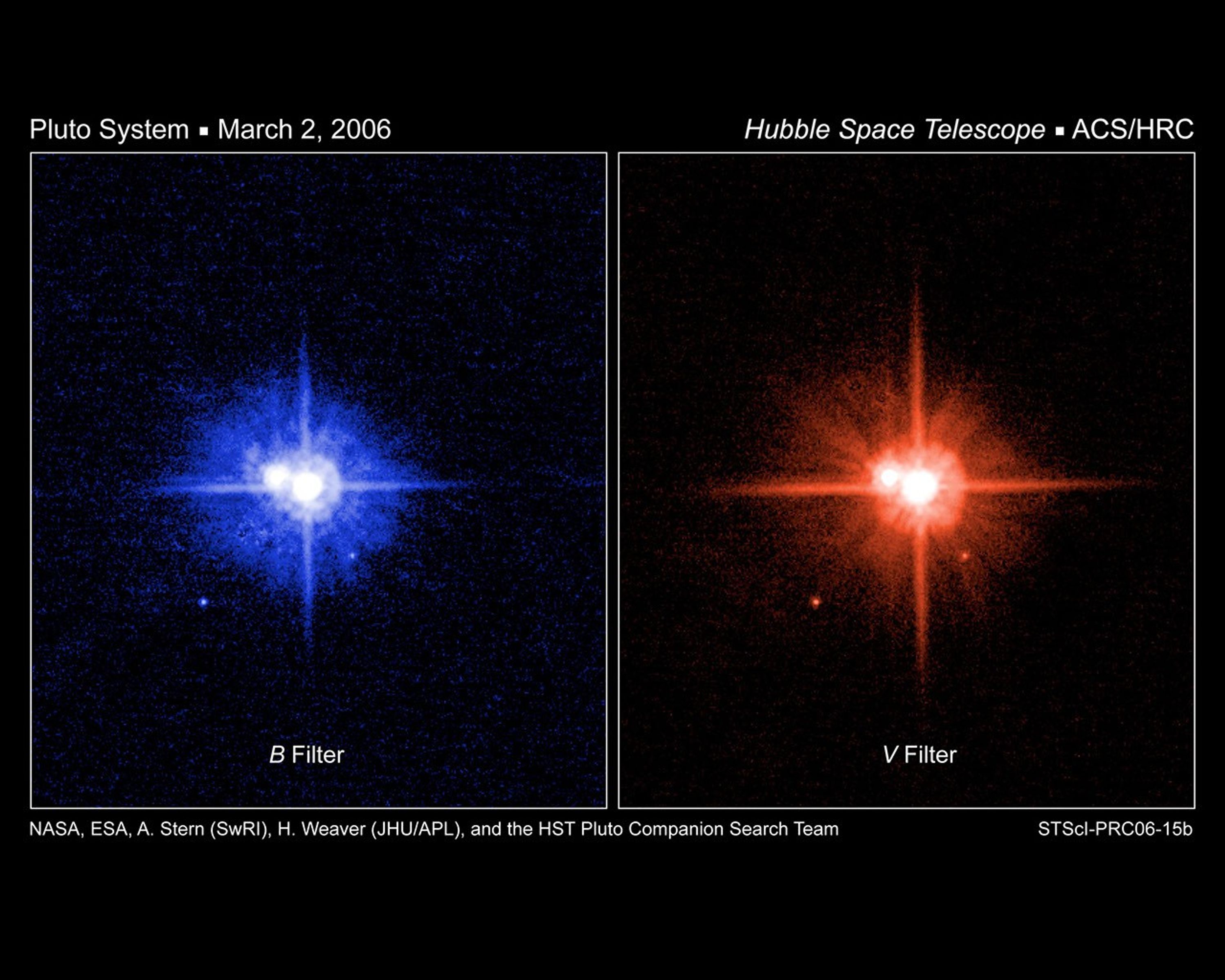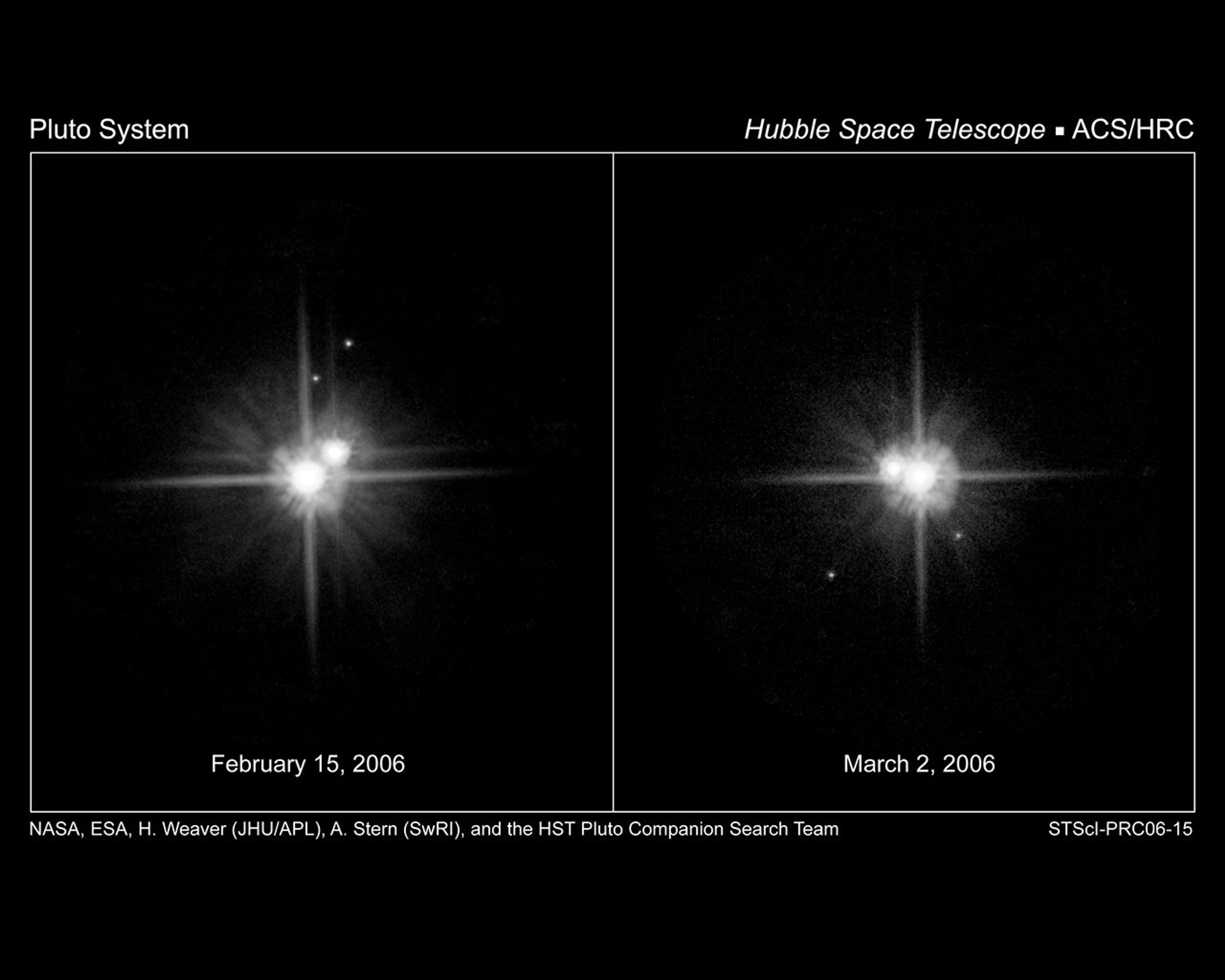1 min read
Hubble Color Images of Pluto’s Moons Support a Common Birth

These NASA Hubble Space Telescope images of Pluto were taken on March 2, 2006, using the High Resolution Channel (HRC) of the Advanced Camera for Surveys (ACS). The image on the left was taken through a blue filter (F435W), and the one on the right was taken through a red filter (F606W). By comparing these two images in detail, astronomers discovered that the surfaces of Pluto's two newly-discovered satellites (S/2005 P 1 and S/2005 P 2, or P1 and P2 for short) have essentially the same color as Charon's surface. All three satellites have surfaces that reflect sunlight with equal efficiency at all wavelengths, which means they have the same color as Earth's moon (in the absence of Earth's atmospheric effects which can alter the apparent color of our moon). In contrast, Pluto's surface has a reddish hue. The remarkable similarity in the colors of the satellites supports the idea that they were all created from material stripped from the surface layers of Pluto during the giant impact that created the entire system more than 4 billion years ago. (Note that the color schemes used to display the images are not meant to represent the colors of the objects. Rather, a blue intensity scale is used for the image taken through the F435W filter and a red intensity scale is used for the F606W image simply to highlight that the images were obtained through two different filters.)
About the Object
- DistanceDistanceThe physical distance from Earth to the astronomical object. Distances within our solar system are usually measured in Astronomical Units (AU). Distances between stars are usually measured in light-years. Interstellar distances can also be measured in parsecs.Although its orbit is highly eccentric, Pluto's average distance from the Sun is 39.44 Astronomical Units (A.U.) or roughly 3.6 billion miles (5.9 billion kilometers).
- DimensionsDimensionsThe physical size of the object or the apparent angle it subtends on the sky.Pluto has a diameter of roughly 1,416 miles (2,280 km) at the equator.
About the Data
- Data DescriptionData DescriptionProposal: A description of the observations, their scientific justification, and the links to the data available in the science archive.
Science Team: The astronomers who planned the observations and analyzed the data. "PI" refers to the Principal Investigator.These HST data are from proposal 10774: H.A. Weaver (JHU/APL), S.A. Stern and J.R. Spencer (SwRI), M.W. Buie (Lowell Obs.), E. Young, L.A. Young, and A.J. Steffl (SwRI), M. Mutchler (STScI) and W.J. Merline (SwRI). - InstrumentInstrumentThe science instrument used to produce the data.HST>ACS/HRC
- Exposure DatesExposure DatesThe date(s) that the telescope made its observations and the total exposure time.March 2, 2006
- FiltersFiltersThe camera filters that were used in the science observations.Left: F435W (B) Right: F606W (V)
- Object NameObject NameA name or catalog number that astronomers use to identify an astronomical object.Pluto
- Object DescriptionObject DescriptionThe type of astronomical object.Dwarf Planet with Satellites
- Release DateMarch 10, 2006
- Science ReleaseHubble’s Latest Look at Pluto’s Moons Supports a Common Birth
- Credit

Color Info
Color InfoA brief description of the methods used to convert telescope data into the color image being presented.
Blue: F435W (B) Red: F606W (V)
Related Images & Videos

Hubble's Latest Look at Pluto's Moons Supports a Common Birth
This pair of NASA Hubble Space Telescope images shows the motion of Pluto's satellites between February 15th and March 2nd, 2006. Both images were taken through a red filter (F606W) using the High Resolution Channel (HRC) of the Advanced Camera for Surveys (ACS). During this...

Schematic of the Pluto System
The new HST/ACS observations made on March 2nd reveal that all three of Pluto's satellites are neutrally colored, unlike reddish Pluto itself. Pluto's reddish color is believed to be due to reddening agents created by the effects of sunlight acting on its nitrogen and methane...
Share
Details
Last Updated
Aug 17, 2025
Contact
Media
Claire Andreoli
NASA’s Goddard Space Flight Center
Greenbelt, Maryland
claire.andreoli@nasa.gov

































